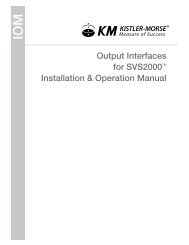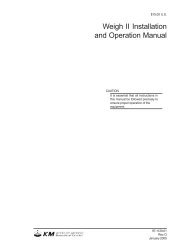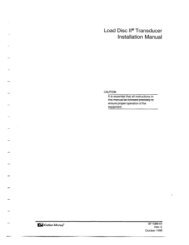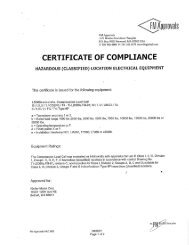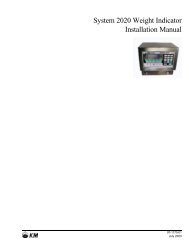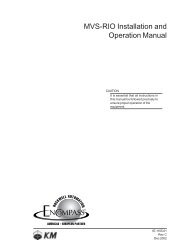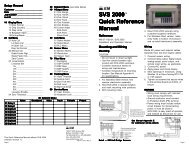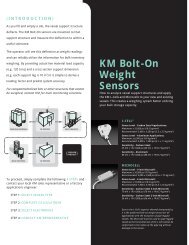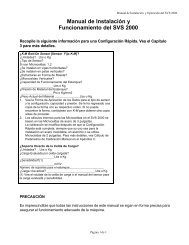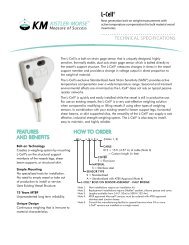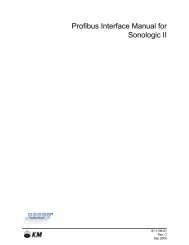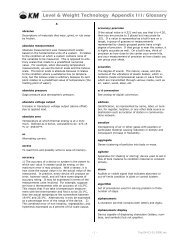STX Signal Transmitter Installation and Operation ... - Kistler-Morse
STX Signal Transmitter Installation and Operation ... - Kistler-Morse
STX Signal Transmitter Installation and Operation ... - Kistler-Morse
You also want an ePaper? Increase the reach of your titles
YUMPU automatically turns print PDFs into web optimized ePapers that Google loves.
Chapter 7. MVS-<strong>STX</strong> Calibration Menu<br />
3. Press the Menu Key to display the Main<br />
Menu. The display shows:<br />
MAIN MENU<br />
F1 F2 F3<br />
4. Press the F3 Key to access the Cal<br />
Menu. The display shows:<br />
CALIBRATION MENU<br />
5. Press the F1 Key to access the Auto<br />
Menu. The display shows:<br />
AUTO CAL MENU<br />
F1 F2 F3<br />
6. Press the F1 Key to access LoSpan. The<br />
display looks like this:<br />
LO SPAN AUTO CAL<br />
(Units are consistent with Units Menu.)<br />
7. Use the keypad or Arrow Keys to input a<br />
value that represents the estimated<br />
quantity of material in the vessel. Press<br />
the Enter Key. The display acknowledges<br />
the entry <strong>and</strong> returns to:<br />
AUTO CAL MENU<br />
Note<br />
Disp I/O Cal <br />
Auto<br />
LoSpan<br />
LoSpan<br />
Manual<br />
F1 F2 F3<br />
HiSpan<br />
> 0 lbs<br />
F1 F2 F3<br />
HiSpan<br />
F1 F2 F3<br />
If the filling process takes a long time<br />
<strong>and</strong> you need to use the MVS to<br />
monitor vessel contents during filling,<br />
enter ScfCnt, ScfWgt, <strong>and</strong> then<br />
Zero_Cal now. (If you do not, disregard<br />
channel monitoring data until you<br />
complete the Auto Calibration in<br />
Steps 8 through 10.) Complete the<br />
Auto calibration as described below.<br />
8. Add a known quantity of material,<br />
representing at least 25% of the vessel’s<br />
total capacity, to the vessel.<br />
9. Press the F3 Key to access HiSpan. The<br />
display looks like this:<br />
HI SPAN AUTO CAL<br />
> 9999 lbs<br />
F1 F2 F3<br />
(Units are consistent with Units Menu.)<br />
10. Using the keypad or Arrow Keys, input<br />
the value equal to the sum of the known<br />
quantity (Step 8) <strong>and</strong> the estimated<br />
quantity (Step 7). Press the Enter Key.<br />
The display acknowledges the entry <strong>and</strong><br />
returns to:<br />
AUTO CAL MENU<br />
LoSpan<br />
HiSpan<br />
F1 F2 F3<br />
11. Press the Esc Key to scroll up the menu<br />
tree or press the Auto/Man Key to return<br />
to channel monitoring.<br />
Note<br />
Shifting from the dashed to the solid<br />
line in Figure 7-3 is accomplished by<br />
setting zero when the vessel contains<br />
a known quantity of material (usually<br />
none) at a later date. The procedure is<br />
described in Refining the Calibration<br />
by Setting Zero in this section.<br />
Calibration by Subtracting a<br />
Known Quantity of Material<br />
This calibration method does not require the<br />
vessel to be empty. This method of calibration<br />
is appropriate when it is easier to remove<br />
material from the vessel than to add it. The<br />
principle behind the calibration follows.<br />
A value estimated to be the quantity of<br />
material in the vessel is entered as the<br />
Hi Span weight [point (2) in Figure 7-3].<br />
A known quantity of material, representing at<br />
least 25% of the vessel’s total capacity, is<br />
removed from the vessel. The estimated<br />
Hi Span weight minus the known quantity<br />
that is removed is entered as the Lo Span<br />
weight [point (1) in Figure 7-3]. The MVS<br />
saves in memory the Lo Span <strong>and</strong> Hi Span<br />
weights as well as the digital counts associated<br />
with each weight. These values define<br />
the dashed straight line <strong>and</strong> the calculated<br />
zero counts shown in Figure 7-3. The slope of<br />
the line is called the Scale Factor, which is<br />
calculated internally.<br />
The slope of the line is reasonably accurate,<br />
because it is calculated based on the known<br />
difference between the Lo Span <strong>and</strong> Hi Span<br />
weights <strong>and</strong> counts. However, if the estimated<br />
Hi Span weight is incorrect, the actual<br />
‘location’ of the line is incorrect, resulting in<br />
7-4



